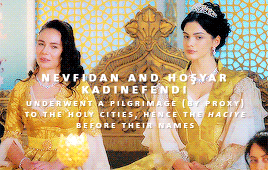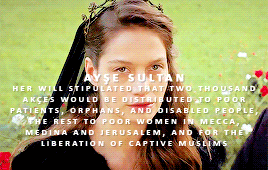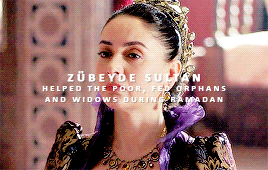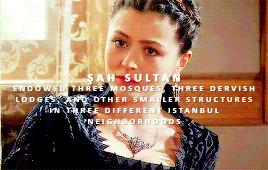#gevheri kadin
Explore tagged Tumblr posts
Photo






OTTOMANLADIES’ 2ND BIRTHDAY CELEBRATIONS
particularly pious or religious ottoman women -- requested by anon
#history#historyedit#ottoman history#kosem sultan#nevfidan kadin#hosyar kadin#zubeyde sultan daughter of ahmed iii#ayse sultan daughter of murad iii#gevheri kadin#sahihuban sultan daughter of selim i#ottomanladiesedit#*requested
241 notes
·
View notes
Note
The youngest ottoman consorts to become mothers
As we don't have precise dates of birth for consorts until the XIX century (and sometimes even after that), answering this question is not easy at all.
I have found that:
Gülcemâl Kadın, the mother of Mehmed V, was 14 years old when she gave birth to her eldest child, Fatma Sultan.
Nesrin Hanım, another consort of Abdülmecid I, was 16 years old when she gave birth to Şehzade Mehmed Ziyaeddin.
Şayeste Hanım was 15 years old when she gave birth to Şehzade Abdullah.
Ayşe Serfiraz Hanım too was 15 when she gave birth to Şehzade Osman Safiyeddin.
Edadil Kadın, consort of Sultan Abdülaziz, was 17 when she gave birth to Şehzade Mahmud Celaleddin.
Gevheri Kadın too was 17 when she gave birth to Esma Sultan.
Mezide Mestan Kadın, consort of Abdülhamid II, was 16 when she gave birth to Şehzade Mehmed Burhaneddin
Mihrengiz Kadın, consort of Mehmed V, was 17 when she gave birth to Şehzade Ömer Hilmi
Şehsuvar Kadın, consort of Caliph Abdülmecid II, was 17 years old when she give birth to Şehzade Ömer Faruk
#anon#ask post#ask: ottoman history#gulcemal kadin#nesrin hanim#sayeste hanim#serfiraz hanim#edadil kadin#gevheri kadin#mezide mestan kadin#mihrengiz kadin#sehsuvar kadin#Anonymous
17 notes
·
View notes
Text
Sultân Abdülazîz + family
Consorts:
Dürr-i Nev Başkadınefendi (15.3.1835-4.12.1895): born Princess Melek Dziapş-lpa, she was the daughter of Prince Mahmud Bey Dziapş-lpa and Princess Halime Hanım. She was the eldest of three sisters and entered palace service with her younger sister Princess Ayşe Kemalifer. She became a lady of Servetseza Kadınefendi and received a good education: she was a good pianist and could speak French without an accent. She also made some paintings which she later gave to Bezmialem Valide Sultan and Servetseza Kadınefendi. Dürrinev had long blonde hair and hazel eyes; when the future Sultan Abdülaziz first saw her, he immediately asked Servetseza Kadınefendi to let him marry his lady-in-waiting. The wedding took place on 20 May 1856 in Dolmabahçe Palace; a year later she gave birth to Yûsuf İzzeddîn Efendi (1857-1916), then to Saliha Sultan (1862-1941). After Abdülaziz's dethronement, she was imprisoned in Feriye Palace in the apartments above his. She fainted when she saw his corpse. She died on 4 December 1895 and was buried in the mausoleum of Mahmud II.
Edâ-dil Kadınefendi (1845?-1875): Second Imperial Consort, she was Abkhazian and was the daughter of Prince Aredba Tandal Bey. She entered palace service at a young age, where she was especially liked by Pertevniyal Valide Sultan. Edadil was given to Sultan Abdülaziz as a gift for his accession to the throne. She was said to be beautiful, with blue eyes and brown hair. She was the mother of Mahmûd Celâleddîn Efendi (1862-1888) and Emine Sultan (1866-1867). The sudden death of her brother affected her a lot and she died young in 1875. She was buried in the mausoleum of Mahmud II.
Hayrân-ı Dil Kadınefendi (1846-1895): Second Imperial Consort after the death of Edâ-dil Kadınefendi. There is no certain information about her background and family, nor how she entered palace service before becoming a consort. She married Sultan Abdülaziz on 21 September 1865, a year later she gave birth to Nazime Sultan (1866-1895/1947) and then to Caliph Abdülmecid II (1868-1944). After the deposition of Murad V, she was allowed to retire to Ortaköy Palace. She died on 26 November 1895 and was buried in the mausoleum of Mahmud II.
Neşerek Kadınefendi (1848-1876): Third Imperial Consort, she was most probably Caucasian and born in Sochi to Prince İsmail Bey Zevş-Barakay. She married Sultan Abdülaziz in 1868. She was the mother of Mehmed Şevket Efendi (1872-1899) and of Emine Sultan (1874-1920). She died on 11 June 1876 and was buried in the Yeni Mosque.
Gevheri Kadınefendi (1856-1884): Fourth Imperial Consort, she was the mother of Esma Sultan (1873-1899) and Mehmed Seyfeddin Efendi (1874-1927). Her real name was Enime, her father was Salih Bey and her mother was the daughter of Prince Tsanba Osman Bey. She had long curly auburn hair and blue eyes. She always wore white dresses and a light blue veil on her head; her only jewelry were the rings Abdülaziz gave her on their wedding day in 1872. Gevheri was a very charitable women: she helped the poor however she could, paid for the education of young orphans and even supplied funds to repair several mosques and schools. She died in Ortaköy Palace on 6 September 1884 and was buried in the Yeni Mosque.
Children
Şehzade Yûsuf İzzeddîn Efendi (11.10.1857-1.2.1916): Abdülazîz's eldest child, he was kept secret in Kadri Bey's villa in Eyüp until his accession to the throne in 1861. He was considered the true heir to the throne by his father, who tried throughout his reign to change the line of succession to primogeniture. Izzeddin travelled to Europe with his father at 10 years old and later, in 1910, represented the Ottoman Dynasty at the funeral of Edward VII of the United Kingdom. He had five consorts and four children: Șehzade Mehmed Bahaeddin (2.1883 - 8.11.1883), Hatice Şükriye Sultan (24.2.1906 - 1.4.1972), Șehzade Mehmed Nizameddin (18.12.1908-19.3.1933) and Mihriban Mihrişah Sultan (30.8.1916 -25.1.1987)
Saliha Sultan (10.8.1862-1941): Şehzade Izzeddin's full-sister. She was born in Dolmabahçe Palace. At the age of 13, she was engaged to the son of the Khedive of Egypt, but Abdulhamid II broke the engagement, and Saliha Sultan had to wait 13 more years before getting married. In 1889 she married Ahmed Zülküf Bey (later Paşa), who was said to have been very handsome. Their only child was Kâmile Hanım-Sultân (1890-1896). She moved to Egypt after the Dynasty was exiled and died in poverty at the age of eighty.
Şehzade Mahmud Celaleddin Efendi (14.11.1862-1.9.1888): he was Vice Admiral of the Imperial Army, a pianist and a flautist. His aunt Adile Sultan, a renowned poet, wrote several compositions to celebrate him.
Nazima Sultan (25.2.1866-1895/1947): daughter of Second Imperial Consort Hayrân-ı Dil Kadınefendi, she studied French in childhood. She married Dâmâd Alî Hâlid Paşâ on 20 April 1889. While Öztuna claims that she died in 1947, Sakaoğlu believes that his source, N. S. Örik, mistook Nazima for her elder sister Saliha.
Şehzade Mehmed Selim Efendi (28.10.1866-21.10.1867): buried in the mausoleum of Mahmud II
Emine Sultan (30.11.1866-23.1.1867): buried in the mausoleum of Mahmud II
Caliph Abdülmecid II (29.5.1868-23.8.1944): younger child of Second Imperial Consort Hayrân-ı Dil Kadınefendi, he was the last Caliph of the Ottoman Empire.
Şehzade Mehmed Şevket Efendi (5.6.1872-22.10.1899): son of Third Imperial Consort Neşerek Kadınefendi, he was only 4 years old when he lost his father so he grew very close to his uncle Abdülhamîd II, who took him to Yildiz Palace and raised him alongside his sons. He was married to Fatma Rûy-i Nâz Hanımefendi and had a son, Mehmed Cemâleddîn Efendi (1891-1947).
Esma Sultan (21.3.1873-7.5.1899): daughter of Fourth Imperial Consort Gevheri Kadınefendi, according to Alderson she was instead daughter of Neşerek Kadınefendi. As she had lost her father at the age of three, she grew up in the household of her eldest brother Şehzade Yûsuf İzzeddîn Efendi. She was very beautiful: tall, slim, with black eyes and very white skin. On 20 April 1889 she married Dâmâd Kabasakal Çerkes Mehmed Paşa, 20 years her senior and previously the husband of her aunt Naile Sultan. She had five children: Sultân-zâde Hasan Bedreddîn Beyefendi (1890-29.1.1909), Sultân-zâde Hayreddîn Beyefendi (1892-1987), Mihribân Hanım-Sultân (1894-1894), Sultân-zâde Sâ'deddîn Beyefendi (14.6.1895-1970s) and Sultân-zâde 'Abdullâh Beyefendi (1899-stillborn). Esma Sultan died after delivering her fourth son and fifth child.
Fatma Sultan (1874-1875): buried in the mausoleum of Mahmud II
Emine Sultan (24.8.1874-29.1.1920): daughter of Neşerek Kadınefendi, she was raised in the household of her eldest brother Şehzade Yûsuf İzzeddîn Efendi. She married Dâmâd Mehmed Şerif "Çavdaroğlu" Paşa in 1901 and had a daughter with him, Hamide Hanım-Sultân, who died in infancy.
Şehzade Mehmed Seyfeddîn Efendi (22.9.1874-19.10.1927): Vice Admiral of the Ottoman army, he was a great musician, a student of Callisto Guatelli. In 1914 he bought the organ from the Chapelle St. Louis and had it brought to Istanbul. He had two consorts and four children: Şehzade Mehmed Abdülazîz Efendi (1901-1977), Şehzade Mahmud Sevket Efendi (1903-1973), Şehzade Ahmed Tevhid Efendi (1904-1966) and Fatma Gevheri Sultan (1904-1980)
Münire Sultan (1877): posthumous child, she died in infancy.
#history#ottoman history#Abdulaziz#*consortsandchildren#durrinev kadin#edadil kadin#hayranidil kadin#neserek kadin#gevheri kadin#sehzade yusuf izzeddin son of abdulaziz#saliha sultan daughter of abdulaziz#nazima sultan daughter of abdulaziz#esma sultan daughter of abdulaziz#emine sultan daughter of abdulaziz#sehzade mahmud celaleddin son of abdulaziz#abdulmecid ii#sehzade mehmed sevket son of abdulaziz#sehzade mehmed seyfeddin son of abdulaziz
20 notes
·
View notes
Text
On this day, 6 September, in Ottoman history:
6 September 1825 - birth of Hatice Sultan: daughter of Mahmud II and Fourth Imperial Consort Pervîz-felek Kadın, she was Atiye Sultan's younger full-sister. She died at the age of 17 of smallpox, on 19 December 1842. She was buried in the mausoleum of her father.
6 September 1884 - death of Gevheri Kadın: Fourth Imperial Consort of Sultan Abdülaziz, she was Abkhazian. She was the mother of Esma Sultan (1873-1899) and of Prince Mehmed Seyfeddin Efendi (1874-1927). Gevheri Kadın was a very affectionate woman who helped the poor and supported education of the orphans; she also provided funds for the repairs of mosques and madrasas. After the deposition of Sultan Abdülaziz, she lived in Ortaköy Palace until her death on 6 September 1884. She was buried in the courtyard of the New Mosque.
#history#ottoman history#on this day in history#on this day in ottoman history#hatice sultan daughter of mahmud ii#pervizfelek kadin#gevheri kadin#late ottoman empire
17 notes
·
View notes
Text
On this day, 8 July, in Ottoman history
8 July 1856 - birth of Gevheri Kadın: Sultan Abdülaziz's Fourth Imperial Consort was born Emine in Abkhazia to Salih Bey and Şaziye Hanım, daughter of Prince Tsanba Osman Bey. Emine was sent to the Palace at a young age, where she was trained by the valide sultan Pertevniyal to become one of her son's consorts. She had long curly brown hair and blue eyes; she always wore white long dresses with a light blue hotoz on her head and a red shawl tied at her hips. The only jewelry she wore were the rings Sultan Abdülaziz had given her on their wedding day. She gave birth to Esma Sultan in 1873 and to Prince Mehmed Seyfeddin Efendi in 1874. Gevheri Kadın was a very affectionate woman who helped the poor and supported education of the orphans; she also provided funds for the repairs of mosques and madrasas. After the deposition of Sultan Abdülaziz, she lived in Ortaköy Palace until her death on 6 September 1884. She was buried in the courtyard of the New Mosque.
8 July 1905 - wedding between the future Mehmed VI and Inşirah Hanım: set in Çengelköy Palace, the bride was significantly younger than the groom and was actually forced to marry him by her family. The marriage would produce no children.
#history#on this day in history#on this day in ottoman history#abdulaziz#gevheri kadin#mehmed vi#insirah hanim#late ottoman empire#esma sultan daughter of abdulaziz
16 notes
·
View notes
Note
Can you replace all twins in the Ottoman family and have they ever been triplets.
Hello! This is the list that Alderson compiled in his book Structure of the Ottoman Dynasty:
(disputed) Şehzade Cihangir and Şehzade Süleyman (2.1585) to Murad III, mother unknown
Şehzade Ibrahim and Şehzade Selim (7.10.1692) to Ahmed II and Haseki Rabia Sultan
Şehzade Ahmed and Şehzade Murad (3.3.1703) to Mustafa II and Hafsa Kadin
Ümmügülsüm Sultan and Zeynep Sultan (11.2.1708) to Ahmed III, mother unknown
Şehzade Selim and Saliha Sultan (21.3.1715) to Ahmed III and Hatem Kadın
Şehzade Mahmud and Şehzade Mehmed (18.2.1822) to Mahmud II, mother unknown
Hatice Sultan and Refia Sultan (8.1.1842) to Abdülmecid I and Gülcemal Kadın
Şehzade Mehmed Nizameddin and Şehzade Mehmed Vamik (19.4.1850) to Abdülmecid I
Şehzade Ahmed Nureddin and Şehzade Mehmed Bedreddin (22.6.1901) to Abdülhamid II and Behice Hanım
Şehzade Ahmed Tevhid and Fatma Gevheri Sultan (2.12.1904) to Şehzade Mehmed Seyfeddin and Nervaliter Hanım
It’s possible that there were others that were not recorded.
Triplets? No, sorry, I have never heard of triplets in the Dynasty. Giving birth to three children at the time would have been an extraordinary feature so if nobody recorded it, it never happened.
13 notes
·
View notes